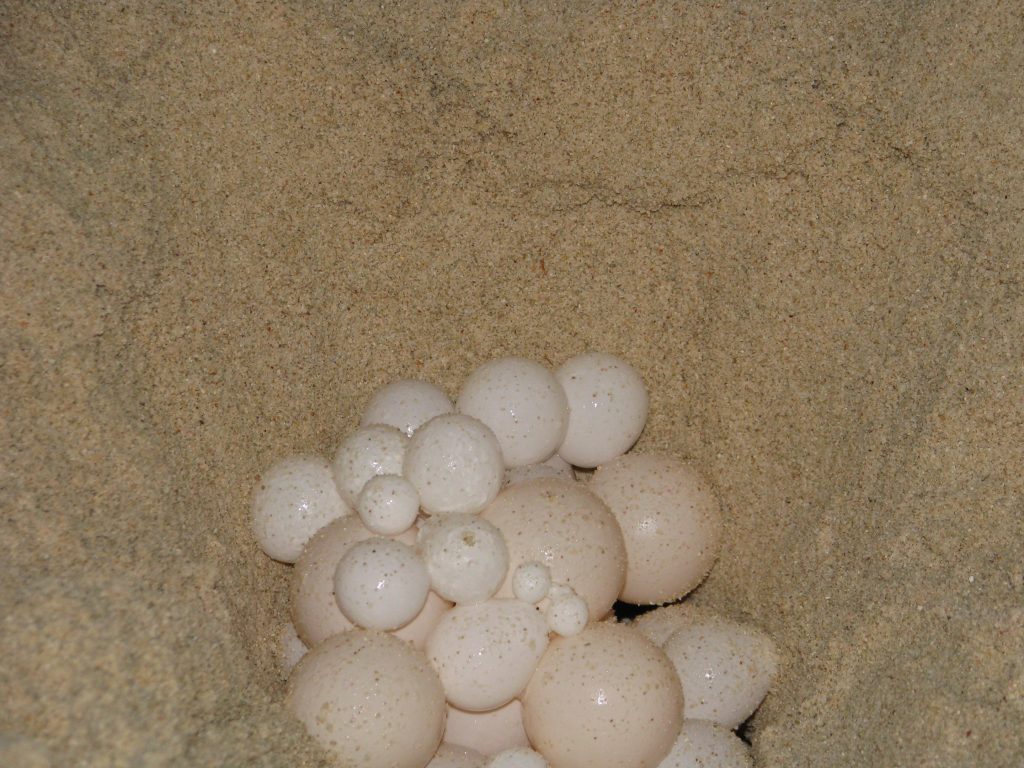Sea turtles spend months as an embryo followed by days as a hatchling digging out of the nest and then minutes in a frenzied crawl across the beach. Despite this short period of time spent on land during a lifespan of decades, it is an important environment for sea turtles. Beach conditions influence embryo development and determine the percentage of eggs which produce hatchlings that can successfully escape the nest to enter the sea.
Temperature, moisture, oxygen and carbon dioxide levels within the nest are all important, but temperature has received the most research attention. This is for two reasons: first, extended periods of time at high temperatures can kill developing turtle embryos; second, the nest temperature at critical stages of development determines the sex of the hatchling, with higher temperatures resulting in a female-biased sex ratio.
The impact of temperature on sea turtle embryos is moderated by the amount of moisture in the sand and these conditions will certainly be impacted by climate change. It is therefore understandable that researchers and conservationists are focused on studying the potential impacts of climate change on hatchling production and sex ratios and how sea turtles may survive a rapidly warming world with fewer, yet more intense periods of rainfall.
When examining data about nesting sea turtles and their eggs, researchers Asghar Mobaraki, Andrea Phillott and colleagues found interesting relationships between environmental conditions and eggs laid across various locations globally. They noticed that a larger than expected number of small eggs—known as ‘yolkless eggs’—are laid by hawksbill turtles in the northern Persian Gulf. Yolkless eggs are not “true” eggs as they contain albumen (egg white) but no yolk or embryo and cannot produce a hatchling.

Previous studies suggest that yolkless eggs are more commonly laid by leatherback turtles worldwide than other sea turtle species, and that yolkless eggs are often among the last eggs laid in a clutch. Their specific purpose (if any) is still unknown: are yolkless eggs produced by accident or do the eggs have a specific function, such as moderating nest temperature, acting as a moisture reservoir, creating spaces between eggs, or being ‘sacrificial’ eggs at the top of the nest for predators to consume?
The researchers compared the body size of nesting hawksbill turtles and the number of normal and yolkless eggs laid in each clutch at different locations around the world. They found that hawksbill turtles nesting in the Persian Gulf and Red Sea are smaller in size than other populations and lay fewer normal eggs. Both locations are semi-enclosed seas and experience extreme marine environments, with high temperatures and salinities.
Such conditions reduce the amount and quality of food available to animals such as hawksbill turtles, which appear to stay within the Persian Gulf or Red Sea during both the breeding and non-breeding periods of their life instead of migrating moderate to long distances as other turtles do. Hence, the smaller size of hawksbill turtles in the Persian Gulf and Red Sea is probably due to less and/or low-quality food, and the smaller body size will only allow turtles to lay fewer normal eggs per clutch than turtles in better quality habitat.

Few yolkless eggs are laid by hawksbill turtles in other locations worldwide, including Australia, Brazil, Mexico, Seychelles, Oman, and Yemen, and so there was very little data available for the researchers to compare. However, the authors found that hawksbill turtles in the Persian Gulf and Red Sea appear to lay more yolkless eggs than other populations and propose that this could be a specific adaptation to the extreme conditions on nesting beaches in these locations.
As previously suggested, yolkless eggs could play a role in moderating nest temperature or moisture and increase the likelihood that normal eggs in the nest will successfully produce a hatchling. This is an exciting finding for researchers and conservationists who are considering how sea turtles could survive the current period of climate change because it suggests that some sea turtle populations may already have adaptations that enable them to survive in challenging environmental conditions which are expected to be more widespread in the future.
Further Reading:
Mobaraki, A., A.D. Phillott, M. Erfani, M. Ghasemi and H. Jafari. 2022. Inferred impacts of extreme environments on hawksbill turtle (Eretmochelys imbricata) body size and reproductive output. Chelonian conservation and biology 21 (2): 187–198.
Author: Andrea Phillott
Photograph: Asghar Mobaraki is a wildlife conservationist with the Department of Environment in Iran. His focus in on research and conservation of reptiles, specifically sea turtles.






